
Wayne
Schmidt's Popcorn Comparison Page Taste
tests with photos of 19 gourmet popcorns.
I've
never been a big popcorn fan, then one day I watched an Alton Brown Good
Eats show about popcorn and began wonder what I'd been missing
all these years. A few minute's research on the Internet turned up
dozens of different gourmet popcorns so I order several, popped them
up and taste tested them to see which were good, which were bad and
which were ugly. This page chronicles which varieties I tested and
how they rated.
Popping
Techniques:
The
first question I had to answer was: What is the best way to pop
popcorn? Although most experts prefer the hot-oil/stove-top
method, I decided to test the big three (hot-air, bag-in-microwave,
and stove top) to see for myself which is best.
Hot-air:
Quick and clean, hot-air poppers have a lot going for them. The fact
that they also make the corn pop 40-percent larger also makes them
attractive. However, I found that the texture of the popcorn left a
lot to be desired. It was very dry and quickly lost its crunchiness
when chewed. After just a couple of bites it was reduced to little
more than pulp. Also, the fact that it pops the kernels so much
bigger means that in a handful of popcorn there is significantly less
mass, which means there is significantly less flavor. Finally, the
surface of the popcorn is so dry that it doen't hold salt or
flavorings very well.
A
secondary issue is that most hot air poppers are very noisy.
Paper
Bag Popping: What could be easier
than tossing some popcorn kernels in oil, dumping them into a paper
bag and letting a microwave work its magic on them for three minutes
to make popcorn? Not much, and the result has a much better texture
than air-popping. But, the texture still breaks down too fast when
it's eaten and popping this way isn't much fun.
Stove-Top:
The traditional technique of popping popcorn in a little oil over the
stove ended up producing the best tasting and best textured popcorn.
It was moist, the most flavorful and maintained its crunchiness to
the last chew. Additionally, the popcorn's surface has just enough
moisture to grab onto and hold salt and flavorings.
It's
also the most fun, even if it does take the longest. There's a
indescribable pleasure in the sound of popcorn popping on a stove.
My
Popping Technique: Having
selected the stove top method as the best, I now had to determine
which stove top method was the best.
I
tried popping in wide flat pans (took too much oil to pop all the
kernels,) and tall narrow-bottomed pans (the focused flames needed
for these tended to cause burning,) and ended up using Alton Brown's
recommended technique of using a stainless steel mixing bowl. Its
shape concentrates the oil and kernels near the heat while holding
the popped kernels up and away from the hottest area where burning occurs.
I
experimented with covering the bowl with a screen or foil. The
screen didn't block all the hot oil splatters and produced popcorn
whose surface was a little too dry to properly hold salt and
seasonings. The foil covering worked best. It trapped enough steam to
keep the popcorn's surface moist enough to hold onto flavorings and
completely blocked oil splatters. (Although the foil prevents me from
watching the kernels pop, it compensates for this by creating a
delightfully mellow "pop" when the kernel explode.)
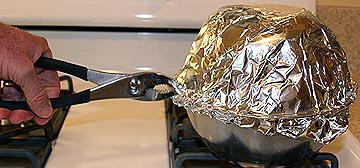
My
popping system. I form the aluminum foil over the bottom
of
the bowl, then turn it over and use it as a cover, crimping it
around
the bowl's lip to hold it in place. I don't bother poking
holes
in it, the seal around the edge is loose enough to let
steam
escape.
I
found that one tablespoon of oil per 2-ounces (56-grams) of popcorn
kernels was optimal. Any more didn't make the popcorn pop any better
and only increased the calories per serving, any less and the last
kernels to pop didn't have enough oil left to do so properly.
I
use the smallest burner on the range to concentrate the heat as much
as possible on the very bottom of the bowl. This keeps the sides
cooler and less likely to burn popped kernels. Even with this, it's
necessary to keep shaking the bowl so burning doesn't occur. Another
good reason to shake is that it helps any unpopped kernels work their
way to the bottom where they can get popped.
Once
the corn finished popping, I quickly remove the aluminum cover and
add any salt or seasonings while the surface of the popcorn still has
enough moisture to hold them. While it's best to eat it right away,
if I want to store for later I found that after cooling it keeps best
if it's placed in a plastic bag. Left exposed to air, in a couple of
hours it begins absorbing moisture and looses some of its crunch.
(One
subtle difference between stove-top and other popping techniques is
that when using the stove-top technique, you are popping the
corn. In the other methods a machine is doing it for you. The
personal touch of shaking the pan and feeling the kernels pop is very satisfying.)
Supercharged
Popcorn?
I'd
read that if popcorn doesn't pop the problem may be that the percent
water inside the kernels is too low. The fix is to add 1 teaspoon of
water to a pound of kernels and seal them in a jar for three days,
shaking it several times a day. The idea is that the humidity in the
jar will rehydrate the kernels enough so they'll pop.
This
got me wondering if doing this to kernels that are already popping
well would boost their pop size. I tried it and have to report total failure.
First
I tried popping some of the kernels right out of the rehydrating
jar. Very few popped and those that did were small and irregular. The
problem was that the hulls had softened to the point where instead of
holding the steam pressure in until it had built up the the
appropriate level, they leaked or popped prematurely.
Next
I let the kernels dry for 4 hours on a paper towel, thinking that
this would allow the hulls to harden. This worked better, with over
half of the kernels popping. But, that still isn't a very high rate
and those that did pop were again, small and deformed.
From
this experiment I conclude that trying to bolster popping vigor by
rehydrating kernels is not as easy as it sounds and may not be worth
the time and effort.
On
To The Taste Tests!
For the
following taste comparisons, I popped all the varieties in the same
way using 56-grams of kernels. I didn't salt the popcorn because it's
impossible to get exactly the same amount of salt on each batch.
Also, I wanted to discover what the different types tasted without
any interfering flavor.
Because taste
is strongly dependent on aroma, immediately before tasting each
variety, while it was fresh off the stove and still warm, I took
several deep inhalations through my nose to make sure I was fully
primed to taste the popcorn's flavor at the fullest.
I measured the
volume each 56-gram portion of kernels popped using a plastic-fronted
box with graduated lines drawn on the front. The following image
shows how air popping (on the left) 56-grams of Orville Redenbacher's
creates a 6-inch high pop whereas oil-popping (on the right) only
pops 4-inches high:
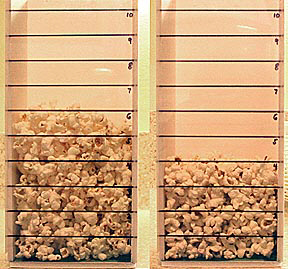
The pop height
is the number after the name in each of the following photos. In
general, higher popping varieties have a light crunchiness and lower
popping varieties a coarser, harder crunch. If your monitor is set to
the standard default of 72-ppi these images will be full size.
First
Up, The Domestics:
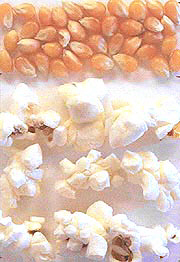
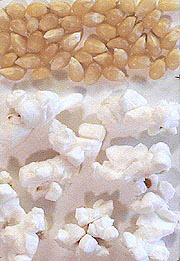

....Jollytime
Yellow (4.5).........Alberton's
White (5).......Stator
Brothers Yellow (4)
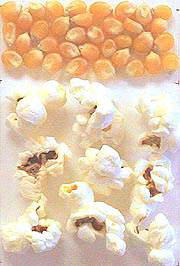
..Orville
Redenbacher's (4)
Contrary
to his commercials, Mr. Redenbacher's popcorn did not pop higher
than the much cheaper grocery store brands. It also didn't taste any
different or have a noticeably different texture. The only difference
I could tell was that it cost three times as much. On the other hand,
it does come in a convenient jar instead of a plastic bag. Close
examination of the kernals show that Orville Redenbacher's are
slightly shorter and rounder than the others.
Gourmet
Popcorns:
I
was pleasantly surprised to discover that exotic gourmet popcorns
don't cost an arm and a leg. They averaged $3.00 for 2-pounds.
Unfortunately, the extra cost of shipping doubles this.
Heartland
Brand:
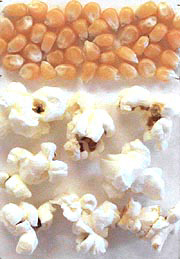
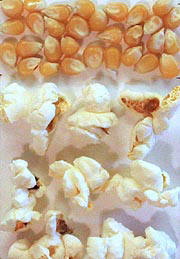
....Virtually
Hull Free (4).............Mushroom
(4)
Heartland's
Virtually Hull Free variety left many hull caps after popping, many
still attached to the popcorn. I found this an unattractive feature.
The Mushroom brand was advertised as popping up into large, round
shapes. I couldn't see any difference between it and other popcorns.
It's texture was a little softer than most.
Fireworks
Brand:
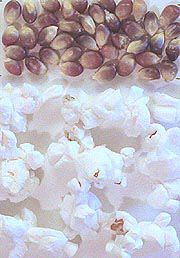
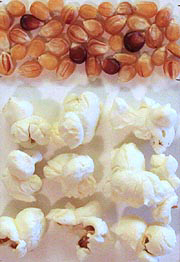
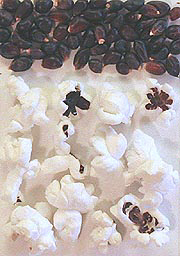
...Orange
Blossom (4.75).........Sunset Fire (3.25)................Black
Hills (3)
Orange Blossom
gave off a very satisfying "pop" when it was popping and
popped higher than most. Both Sunset Fire and Black Hills were very
low poppers. The hull on Black Hills was so dark that it made many of
the popcorn kernels look like they were burnt. It also had a very
coarse and unpleasant crunch.
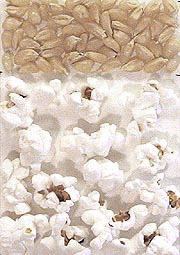
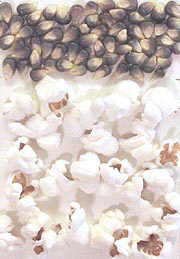

...Baby
White Rice (3.25)..........Blue Heron (2.5).........Wisconsin
White Birch (4.5)
Baby White
Rice is a very small kerneled corn that produces a small popcorn.
It's fun to pop because for the same weight of kernels you have a
greater number of kernals so the popping gets very busy. Because of
their small size, this popcorn has a more refined crunch than others.
Blue Heron had the lowest pop height of any corn and also had a hard
crunch. Wisconsin White Birch was one of the higher poppers.
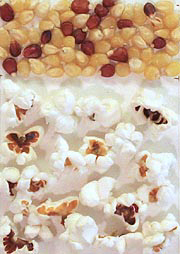
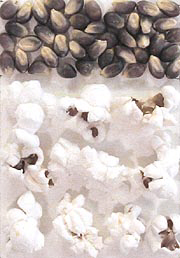
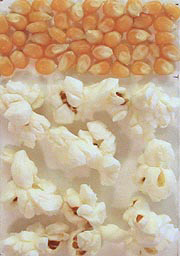
...Autumn
Blaze (3.5).......High Mountain Midnight (2.75).....Savanna
Gold (5.5)
I don't know
if Autumn Blaze (like Sunset Fire) naturally has different colored
kernels in it or if it's a mixture of two types of popcorn. It has a
medium-hard crunch and the hulls from the red kernels make some of
the popcorn look burnt. Although High Mountain Midnight had a lower
pop height, it's crunch was surprisingly delicate. Although it's
difficult to tell from the photo, Savanna Gold had a unique light
yellow color that makes it more attractive than all the other
popcorns, yellow or white. It also had the highest pop height of any
variety and a very energetic pop that was great to listen to. There
were times when I half expected a kernel to burst right through the
foil cover.
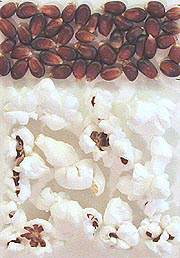
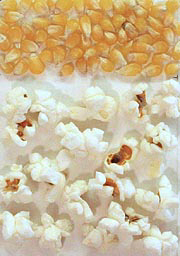

....Red
River Valley (4.5)...........Baby Yellow (2.75).........Starshell
Red (2.75)
Red River
Valley had a very energetic pop but the dark hulls gave some of the
kernels a burnt look. Baby Yellow produced a very small popcorn with
a sharp, busy crunch. If you like lots of fine crunchiness this might
be a good popcorn to try. Starshell Red's very dark hulls made many
of the kernels look burnt and unattractive. It also didn't pop very high.
Amish
Country:
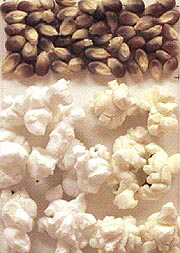
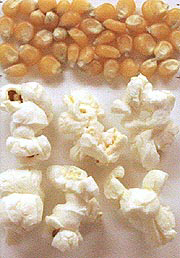
....Gourmet
Purple (4.5).......Extra
Large Yellow (3.75)
Gourmet
Purple produced small popcorn kernels whereas Extra Large Yellow
popped up very large. They were both tough and chewy. One interesting
feature of Gourmet Purple is that although the kernels were all the
same color, they produced a 50/50 mix of white and yellow popcorn. In
the left-hand image above the white is on the left and the yellow is
on the right of the frame. The color difference is more obvious in person.
Taste
Tests:
I saved these
most-important results to the end because many people may find them
controversial. I tasted each variety while it was fresh and still
warm and then again after it had cooled in side-by-side comparisons
to all the other popcorns. The fact is that although I had hoped and
expected to find definite taste differences between the different
varieties, it saddens me to report that if given a blind taste test I
couldn't tell one from the other.
While there
were definite textural differences, no variety of popcorn struck me
as tasting any different from the others. It didn't matter whether it
was the cheapest grocery store brand or the most expensive and exotic
gourmet brand. Considering the expense and effort invested in this
project I found this very disappointing. This doesn't mean that I
don't like popcorn. It's just that I've learned that spending top
dollar for a gourmet variety isn't a guarantee that it's going to
taste any different. I'm sure that there are popcorn experts who can
taste obvious differences between the different types. I couldn't.
Although they
all tasted the same I'm not going to go so far as recommend not
getting any of them. Each of us have different tasting capabilities
and some people may be able to detect difference that I can't. Also,
even if high-end popcorns don't taste any different that doesn't mean
they aren't more fun. The beautiful kernel colors alone give them
valuable entertainment value. It's also more fun to pop up an exotic
popcorn than something purchased at the corner store.
If I had to
choose one popcorn over all the others it would be Savanna Gold by
the Fireworks Popcorn Company. It pops the highest, has the best
texture and is the most beautiful of all the popcorns I compared.
It's also one of the most fun to pop because it's so energetic.
I hope you
enjoyed this page as much as I enjoyed creating it, or at least found
it interesting. I'm sorry I couldn't report that the varieties had
significant flavor differences.
Thank you for
visiting this page and if you want a taste-test page where there
really are differences between the foods compared, try the CANDY
BAR AUTOPSY PAGE
to learn what the best-tasting candy bar in the world is and what
it's made of.

Please click HERE
to visit my main site and browse 100 other pages covering everything
from the Lost Art of Knitting Nancies to how Electric Rocket Engines work.
Copyrights | 2025 | waynesthisandthat.com






















